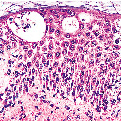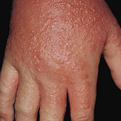Contact Dermatitis
General Information
Contact Dermatitis is an inflammation of the skin caused by direct contact with an irritating substance. A history of any type of allergies is an increasing factor for this condition. Irritant dermatitis is the most common type of contact dermatitis, resulting from contact with acids, alkaline materials such as soaps and detergents, solvents, or other chemicals. Irritant dermatitis has the characteristic of a burn. The second most common type of contact dermatitis is caused by exposure to a material to which the person has become hypersensitive or allergic. The skin inflammation varies from mild irritation and redness to open sores, depending on the type of irritant, the body part affected, and the sensitivity of the individual. Constant use of a product may have no initial reaction, but can cause eventual sensitization and a reaction. Symptoms include pruritus, redness, inflammation of the skin, tenderness, warmth of the exposed area or lesions that may look like blisters or papules Initial treatment is always thorough washing of the affected area to remove any trace of the irritant that may remain on the skin. Further exposure to known irritants or allergens should be avoided. Topical corticosteroid medications can be used to reduce inflammation. In severe cases, systemic corticosteroids may be needed to reduce inflammation. To reduce other symptoms wet dressings, antipruritic (anti-itch), or drying lotions may be recommended.
Epidemiology
Contact dermatitis is the reason for 4-7% of dermatologic consultations
Etiology
Direct contact with an irritating or allergy-causing substance
Pathogenesis
Lesions appear within 24-96 hours of exposure to the allergen.
Clinical
In acute allergic contact dermatitis (ACD), lesions. In irritant contact dermatitis (ICD) thermal burns are noted.
Histology
Findings obtained from biopsy specimens include intercellular edema and bullae
Bibliography
1. “Contact dermatitis” (Online) May 2006. http://www.nlm.nih.gov/medlineplus/ency/article/000869.htm (visited: March 15, 2008) 2. “Contact dermatitis (Online). February 2008. http://www.emedicine.com/emerg/topic131.htm (visited: March 15, 2008)
Download PDF
![]() Contact Dermatitis
Contact Dermatitis


